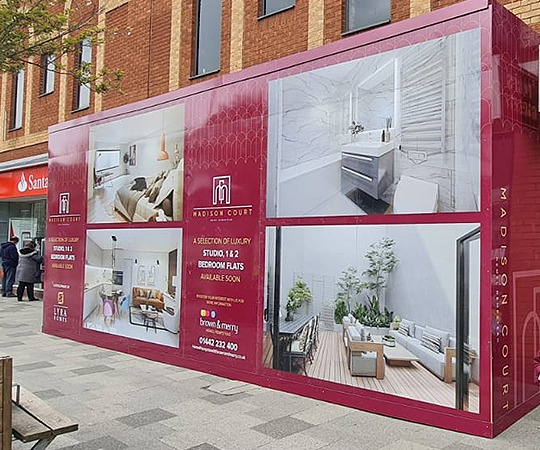
As sustainability becomes more important across industries, companies are now looking for ways to reduce waste and make more eco-friendly choices. In the world of construction, signage, and display materials, the aluminium composite board is gaining popularity—not just for its strength and appearance, but also for its environmental advantages.
In this blog, we’ll explore how recyclable aluminium composite boards offer significant environmental benefits. Whether you’re involved in hoarding board printing, signage, or construction, switching to these boards could help reduce your carbon footprint and support a greener future.
What Is an Aluminium Composite Board?
An aluminium composite board (often called an aluminium composite panel or ACP) is a lightweight yet strong material made of two thin layers of aluminium on the outside, bonded to a non-aluminium core in the middle. This combination makes the board both flexible and durable.
These boards are used in many applications such as:
- Construction hoardings
- Signage and branding displays
- External cladding on buildings
- Exhibition panels
- Shop front fascias
They come in a variety of finishes, colours, and thicknesses, and are easy to cut, print on, and install.
What makes them stand out today is their recyclability—a key feature that supports sustainable practices across industries.

How Recyclable Are Aluminium Composite Boards?
One of the most recyclable materials is aluminium. It retains its quality even if it is melted down and used again. The core of aluminium composite boards is usually made of polyethylene or other plastic materials, which can also be recycled or reused depending on the processing facilities available.
Recycling an aluminium composite board involves separating the aluminium from the plastic core. Although this requires special machinery, many recycling centres in the UK are now equipped to handle this process. This means that instead of ending up in a landfill, old boards can be given a new life as new products.
By recycling these boards, we reduce the need for new raw materials, save energy, and cut down on waste. It’s a small change that can make a big difference when done at scale.
Lower Carbon Footprint in Manufacturing
Producing aluminium from raw bauxite ore is an energy-intensive process. However, recycling aluminium uses up to 95% less energy compared to producing new aluminium. That’s a huge saving in terms of carbon emissions.
When you choose an aluminium composite board made from recycled aluminium, you’re directly contributing to lowering the environmental impact of the production process. In comparison, many other building and signage materials, such as solid plastic panels or PVC boards are not only harder to recycle, but also release more carbon during production.
Choosing recycled aluminium composite boards is an easy way to support cleaner production methods without compromising on performance or appearance.
Durability = Less Waste Over Time
One of the key environmental benefits of aluminium composite boards is their durability. These boards are built to last. They resist weather damage, corrosion, and fading, making them suitable for long-term outdoor use.
In applications such as construction site hoardings or permanent building signage, durability matters. Materials that last longer reduce the need for frequent replacement. That means less production, less transport, and less waste.
In other words, the longer a product lasts, the lower its impact on the environment over time. Aluminium composite boards tick that box very well.
Applications Supporting Sustainability
Recyclable aluminium composite boards are already being used in many eco-conscious projects around the UK. Here are some examples of how they’re being used to reduce environmental impact:
- Construction Site Hoardings: Many developers now opt for aluminium composite boards for temporary hoarding installations. Once the project is complete, the boards can be recycled or reused for future sites.
- Retail Signage: Retailers who update branding seasonally can benefit from boards that are easy to replace and recycle.
- Exhibitions and Events: Lightweight and easy to transport, these boards can be printed on for events, then reused or recycled afterward, reducing waste at trade shows and exhibitions.
By selecting recyclable materials, businesses can show their commitment to the environment while still achieving their visual and functional goals.
A Step Towards the Circular Economy
Aluminium composite boards support the idea of a circular economy. In a circular economy, products are designed to be reused, repurposed, or recycled rather than thrown away.
Using recyclable materials like aluminium helps keep valuable resources in use for longer. When these boards are no longer needed, they can be collected, processed, and turned into new products instead of adding to landfill waste.
This approach reduces the environmental cost of manufacturing and helps businesses align with sustainability goals set by the UK government and international standards.

How to Choose a Sustainable Supplier
If you want to make eco-friendly choices, selecting the right supplier is important. Here are a few things to consider:
- Recycled Content: Ask if the aluminium composite board includes recycled materials.
- Recyclability: Check if the supplier supports take-back schemes or provides guidance on recycling.
- Local Manufacturing: Choosing UK-based suppliers can reduce the carbon footprint of shipping and support the local economy.
- Eco-Friendly Printing: If you’re using boards for signage, find out whether the printing process is environmentally friendly.
When ordering hoarding board printing or any signage, always ask your supplier: “Is this board fully recyclable?”
Final Thoughts: Why Recyclable Aluminium Composite Boards Make Sense
Making eco-conscious choices is more important than ever. Recyclable aluminium composite boards offer a practical way to support sustainability in construction, retail, design, and property development. Lightweight, durable, and cost-effective, these boards are also environmentally friendly. By choosing them, you reduce waste and contribute to a circular economy where materials are reused rather than discarded. Ideal for signage and hoarding board printing, they combine performance with responsibility. For premium, eco-friendly printing on aluminium composite boards, Hoarding Print Company provides trusted solutions that align with your green goals, without compromising on quality, durability, or visual impact.



